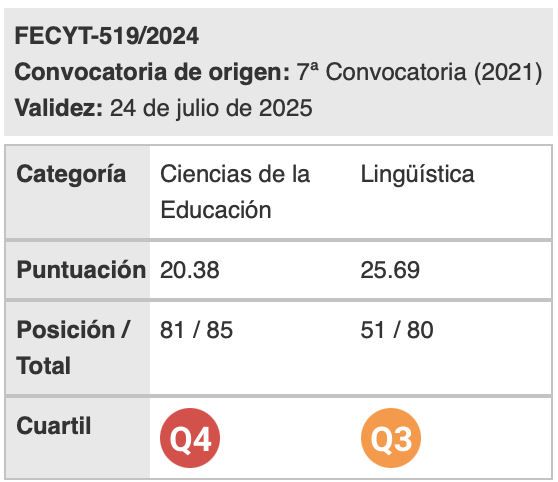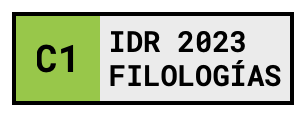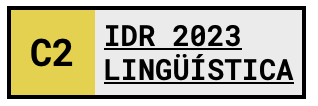La enseñanza integrada de lenguas y contenidos en formación profesional
Palabras clave:
lingüística aplicada, enseñanza de lenguasResumen
This article presents a study into the application of two methodological approaches, teaching through content and language integrated learning in Voca- tional Training from a sequence of activities developed with several groups of students of the Ciclo Superior de Restauración, during two consecutive years. The aim of the study is to evaluate the results of the application of these models, in contrast to more traditional ones, and to inquire into the possibilities that these different methodological approaches can offer for foreign language teaching in Vocational Training. The study questions the effectiveness of the methodological approaches that are being applied at present, mainly for achieving the objectives established in the curriculum in foreign languages. The results show the possibi- lities and limitations of Content-based and Subject Teaching models for intro- ducing subjects in a foreign language within Vocational Training.
Descargas
Citas
Bartolomé, M. (1986). La investigación cooperativa. Educar, 10, 51-78.
Bernaus, M., Moore, E., Cordeiro, A. (2007). Affective factors influencing plurilingual students’ acquisition of Catalan in a Catalan-Spanish bilingual context. The Modern Language Journal, 91(2), 235-246.
Bhatia, V. K. (1986). Specialist-discipline and the ESP curriculum. En Tickoo (Eds.), Language Across the Curriculum (pp. 47-63). Singapur: SEAMEO Regional Language Centre.
Bonet, P. (1997). Applying the Case Study Approach to Students of Business English. En Bonet, P. y Melción, L. (Eds.), La importancia del parámetro sociocultural en la enseñanza del español para fines específicos. ASELE. Actas VIII. Centro Virtual Cervantes.
Bonet, P. y Melción, L. (1997). La importancia del parámetro sociocultural en la enseñanza del español para fines específicos. ASELE. Actas VIII. Centro Virtual Cer- vantes.
Brinton, M. D., Snow, M. A., Wesche, M. B. (1989). Content-based second lan- guage instruction. Boston: Heinle & Heinle Publishers.
Bunk, G. (1994). Impartición de competencias en la formación profesional inicial y continua en Alemania. Revista europea de Formación Profesional, 1, 9-15.
Clegg, J. (2003). Teaching subjects through a foreign language in the primary school. En Teaching Knowledge Test Content and Language Integrated Learning. [En línea] Disponible en <http://www.cambridgeesol.org/assets/pdf/resources/teacher/clil_glossary.pdf>.
Coffey, B. (1985). ESP-English for Specific Purposes. En Kinsella, V. (Ed.) Cambridge Language Teaching Surveys 3, (pp. 78-93). Cambridge: CUP, CILT & The British Council.
Coyle, D. (2005). Developing CLIL: Towards a Theory of Practice. APAC Monograph 6. Barcelona: APAC.
Coyle, D. (2007). CLIL: towards a connected research agenda for CLIL peda- gogies. International Journal of Bilingual Education and Bilingualism, 10(5), 543- 562.
Coyle, D., Holmes. B., King, L. (2009). Towards an integrated curriculum: CLIL national statement and guidelines. London: The Languages Company.
Coyle, D., Hood, P., Marsh, D. (2010). CLIL. Cambridge: CUP.
Cummins, J. (1989). Bilingual special education. En Husen, T. & Postlethwaite, T. N. (Eds.), The international encyclopedia of education: Research and studies. Supplementary vol. 1 (pp. 104-107). Oxford: Pergamon Press.
Dalton-Puffer, C. (2008). Outcomes and processes in CLIL: current research from Europe, in Delanoy, W. y Volkman, L. (Eds.), Future Perspectives for Eng- lish Language Teaching. Heidelberg: Carl Winter.
Dow, A. & Ryan, J. (1987). Preparing the language student for professional interaction. En Bonet, P. y Melción, L. (Eds.), (1997). La importancia del pará- metro sociocultural en la enseñanza del español para fines específicos. ASELE. Actas VIII. Centro Virtual Cervantes.
Fernández, A. (2008). CLIL in Spanish Education: Proposal of a Framework for Implementing a Technology-Enhanced Model of Content and Language Integrated Lear- ning, Tesis doctoral, Universidad de La Rioja.
Gajo, L. (2007). Linguistic knowledge and Subject knowledge: how does bilin- gualism contribute to subject development? International Journal of Bilingual Education and Bilingualism, 10(5), 563-581.
Greenfell, M. (Ed.) (2002). Modern languages across the curriculum. London: Routledge.
Graddol, N. (2006). English next. London: British Council.
Hayman, J. L. (1981). Investigación y educación. Barcelona: Paidós.
Harrop, E. (2012). Content and Language Integrated Learning (CLIL): Limitations and possibilities. Encuentro 21, 57-70.
Hoyos, M. (2011). La enseñanza-aprendizaje de lenguas extranjeras en Formación Profe- sional. Situación actual y perspectivas de futuro. Tesis Doctoral. Universitat de València.
Hord, S. M. (1981). Working Together: Cooperation or collaboration. Austin: Texas Research and Development Center for teacher Education.
Hutmacher, W. (1997). Key competences in Europe. European Journal of Education, 32, 45-58.
Kornbeck, J. (1999). Enseñanza de idiomas extranjeros, formación profesional y protección del asentamiento industrial. Revista europea de Formación Profesional, 16, 33-43.
Krashen, S. (1985). The input hypothesis: issues and implication. London: Longman. Krashen, S. (1987). Principles and Practice in Second Language Acquisition. Exeter:Prentice Hall International.
Larkin, J. H. & Rainard, B. (1984). A research methodology for studying how people think. Journal of Research in Science Teaching, 21, 235-254.
Lasagabaster, D. (2008). Foreign Language competence in CLIL courses. The Open Applied Linguistics Journal, 1, 31- 42.
Lasagabaster, D. (2009). Language attitudes in CLIL and traditional EFL classes. International CLIL Research Journal, 1(2), 4-16.
Lightbrown, P. y Spada, N. (2006). How Languages are learned. Oxford: OUP.
Long, M. (1991). Focus on form: A design feature in language teaching methodology. En De Bot, K., Ginsberg, R., Kramsch, C. (Eds.), Foreign language research in cross- cultural perspective (pp. 39-52). Amsterdam: John Benjamins.
Long, M. & Robinson, P. (1998). Focus on form: Theory, research, and practi- ce. En Doughty, C. & Williams, J. (Eds.), Focus on form in classroom second langua- ge acquisition (pp. 15-63). Cambridge: Cambridge University Press.
Lyster, R. (1998). Immersion pedagogy and implications for language teaching. En Cenoz, J. & Genesee, F. (Eds.), Beyond Bilingualism: Multilingualism and Multilingual Education (pp. 64-95). Clevedon: Multilingual Matters.
Lyster, R. (2007). Learning & Teaching Languages through Content. Amsterdam: John Benjamins.
Macaro, E. (2008). The decline in language learning in England: getting the facts right and getting real. Language Learning Journal, 36(1), 101-108.
Marsh (ed.) (2002). CLIL/EMILE- The European Dimension: actions, trends and foresight potencial. Brussels: European Commission.
Mehisto, D., Marsh, D., Frigols, M. J. (2008). Uncovering CLIL. Oxford: MacMillan.
Mertens, D. (1991). Schlüsselqualifikationen. Thesen zur Schulung für eine moderne Gesellschaft. En Kornbeck, J. (1999). Enseñanza de idiomas extranjeros, formación profesional y protección del asentamiento industrial. Revista europea de Formación Profesional, 16, 33-43.
Met, M. (1998). Curriculum Decision-Making in Content-Based Second Language Teaching. En Cenoz, J. & Genesee, F. (Eds.), Beyond Bilingualism: Multi- lingualism and Multilingual Education. Clevedon: Multilingual Matters.
Muñoz, C. (2002). Aprendizaje integrado de contenidos y lengua extranjera. En Marsh, D. (Ed.) 2002, CLIL/EMILE- The European Dimension: actions, trends and foresight potencial. Brussels: European Commission.
Nikula, T. & Marsh, D. (1997). Focus on the Classroom. En Marsh, D. & Langé, G. (Eds.) Implementing content and language integrated learning. Jyväskylä: University of Jyväskyla.
Oja, S. y Pine, G. (1983). A two year study of teachers stages of development in relation to collaborative action research report final. En Bartolomé, M. (Ed.), (1986). La investigación cooperativa. Educar, 10, 51-78.
Open University (1979). Research methods in education and social science. Keyness: Milton.
Pachler, N. (2000). Re-examining communicative Language teaching. En Field, K. (Ed.), Issues in modern foreign languages teaching. Oxford: Routledge.
Piotrowski, M. (1982). Business as usual: Using the case method to teach ESL to execu- tives. En Bonet, P. y Melción, L. (Eds.), (1997), La importancia del parámetro socio- cultural en la enseñanza del español para fines específicos. ASELE. Actas VIII. Centro Virtual Cervantes.
Popkewitz, T. S. (1988). Paradigmas e ideologías en la investigación educativa. Madrid: Mondadori.
Robinson, P. (1991). ESP today: A practitioner’s guide. Hertfordshire: Prentice Hall International.
Serra, C. (2008). L’enseignement bi-plurilingue des savoirs disciplinaires. Le Français dans le monde, 355, 28-30.
Skehan, P. (1998). A cognitive approach to language learning. Oxford: OUP.
Snow, M., Met, M. & Genesee, F. (1989). A conceptual framework for the integration of language and content in second/foreign language programs. TESOL Quarterly, 23 (2), 201-217.
Westerfield, K. (1989). Improved linguistic fluency with case studies and a video method. English for Specific Purposes, 8(1), 75-83.
Descargas
Publicado
Cómo citar
Número
Sección
Licencia
Aquellos autores/as que tengan publicaciones con esta revista, aceptan los términos siguientes:
- Los autores/as conservarán sus derechos de autor y garantizarán a la revista el derecho de primera publicación de su obra, el cuál estará simultáneamente sujeto a la Licencia de reconocimiento de Creative Commons que permite a terceros compartir la obra siempre que se indique su autor y su primera publicación esta revista.
- Los autores/as podrán adoptar otros acuerdos de licencia no exclusiva de distribución de la versión de la obra publicada (p. ej.: depositarla en un archivo telemático institucional o publicarla en un volumen monográfico) siempre que se indique la publicación inicial en esta revista.
- Se permite y recomienda a los autores/as difundir su obra a través de Internet (p. ej.: en archivos telemáticos institucionales o en su página web) antes y durante el proceso de envío, lo cual puede producir intercambios interesantes y aumentar las citas de la obra publicada. (Véase El efecto del acceso abierto).

Revista de Lenguas para fines específicos is licensed under a Creative Commons Reconocimiento-NoComercial-SinObraDerivada 4.0 Internacional License.






















